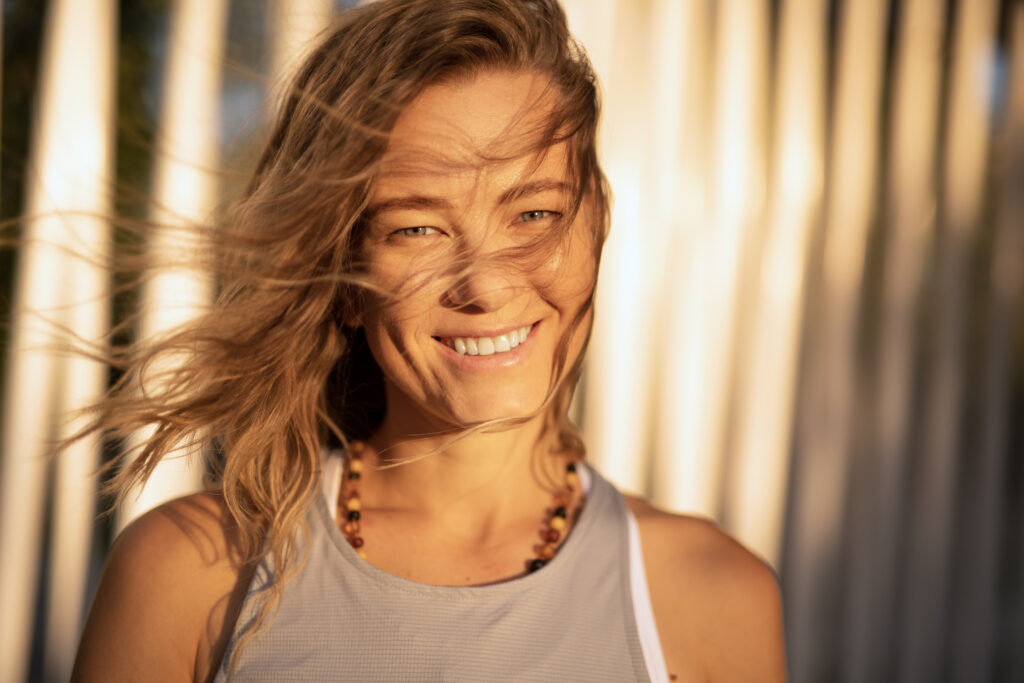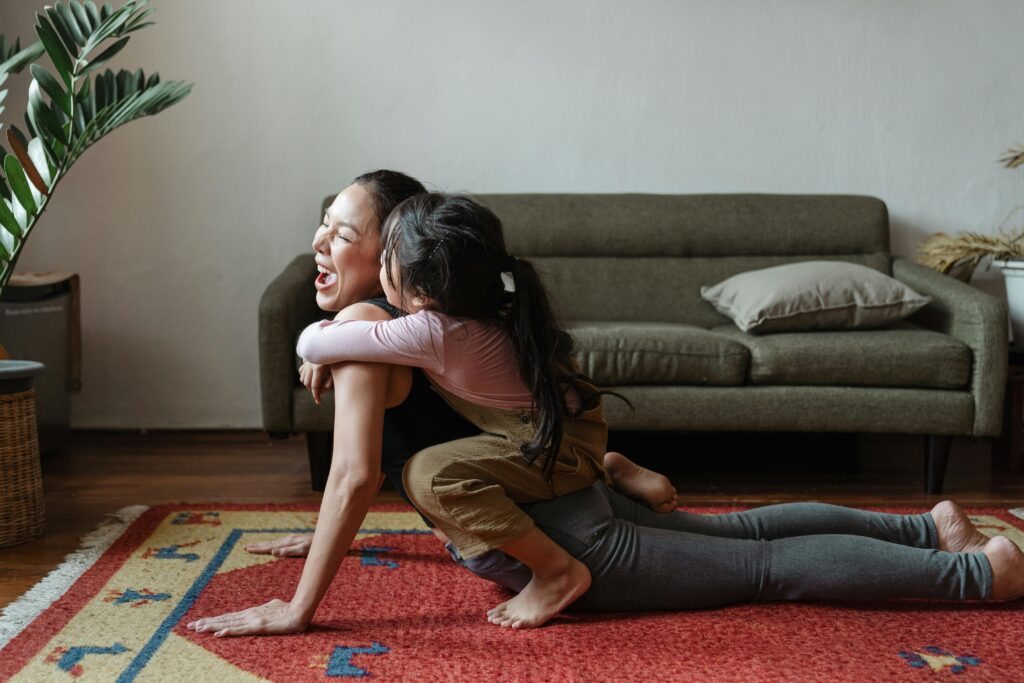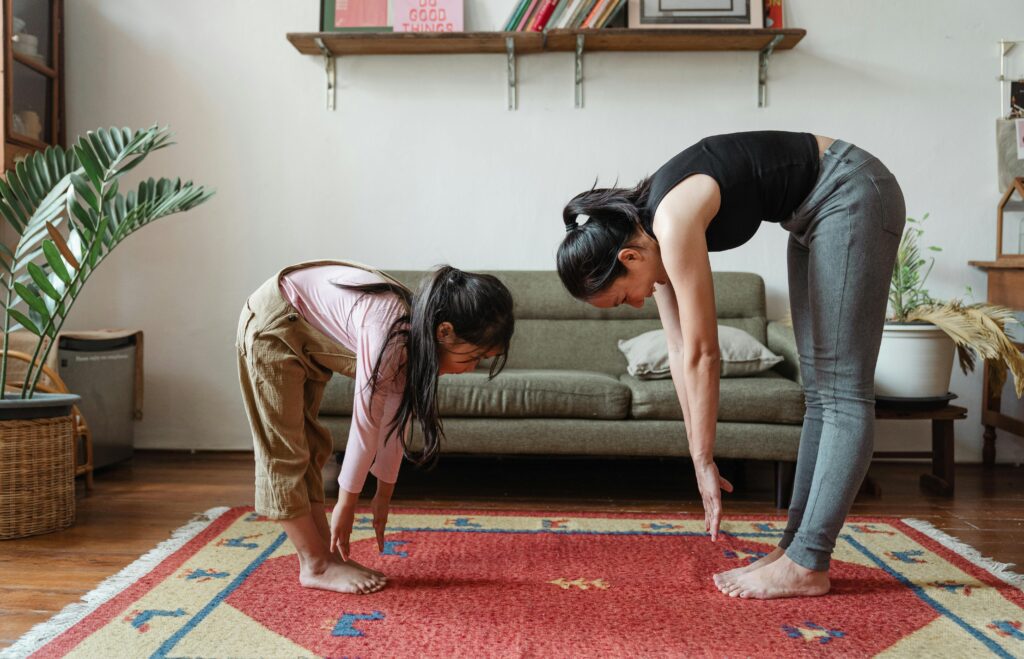We know all the “shoulds” of movement and many of the benefits. Coping with overwhelm and overstimulation is a huge part of that benefit, because it stimulates our senses that are grounding and calming… but often understimulated (read more about that here). So what stops us from regular intentional movement? Often it’s mindset.

As I’m writing, it’s February… and if you made some new years resolutions, maybe they’re pointing their finger at you by now and have you feeling guilty.
Put that guilt aside, exchange it for some compassion and curiosity, and let’s have a heart to heart about movement mindsets and challenges.
This blog post is inspired by my recent conversation with Evgeniia Arasim of At Nourished Motherhood. You can listen along here, with this episode releasing February 19th.
Movement & Nutrition Resources for Moms

I truly enjoyed speaking with Evgeniia, and her transparency and kindness really shine through in our conversation as she shares about her own journey as well. It’s easy to assume that professionals have it all together, but the truth is, we’re busy, imperfect moms too! She has many resources about nutrition and health to help you take your next step on your movement journey! You can access them on her website here.
Moving through overwhelm
Physically moving your body when your mind is stuck in overwhelm helps your mind get “unstuck.” Moving the stress through your body keeps you from getting stuck. It’s of the ways to complete the stress cycle. Of course movement helps with stress, right? You know that. So what holds moms back?
Modeling a mindset of self-compassion through movement
Let’s start here. We know our example is better than a hundred textbooks, and we can model this by how we treat ourselves when it comes to movement. Do we beat ourselves up when we don’t get around to it or don’t do as well as we thought? Our kids are watching us, and they notice the inconsistency in how we treat ourselves and how we treat them.
Evgeniia says, “How do we teach our kids to read or do math? We don’t give them fractions from grade 9. We start small. It’s great for kids to see that we treat ourselves with compassion and kindness, and we treat them the same way. Instead of treating them one way and we treat ourselves another. Children are learning with them how to be compassionate and kind.” Evgeniia shares how important this is, especially as our daughters get older and start to take even more notice.

Creating these healthy habits for ourselves actually serves the whole family.
5 things that might make movement hard
Understanding exactly what’s getting in the way of intentional movement in our lives is key if we want to make progress. It helps us target our efforts instead of shopping for a “one size fits all” solution that will probably only work in the short-term and leave your feeling more frustrated.
Really, the list of barriers could be endless. As Evgeniia says, the human mind can make a barrier out of basically anything. Whether it’s an actual barrier or one our mind has concocted, a barrier is a barrier.
Time
This is a given, right? Finding the time, making the time… however we choose to word it. We can give time specifically to exercise or we can figure out ways to work intentional movement into your daily must-dos. Movement doesn’t have to be 30 minutes, 40 minutes, or an hour. She says, “We have an imaginary picture of what the movement should be, and when it doesn’t happen, we have guilt. Second, we feel like ‘Why even try?’ I guess I’ll just stay here forever.” Finding time to fit movement into our daily routines can be a great place to start. In our conversation, Evgeniia and I talk about ways to exercise in the kitchen and even in the bathroom.
Kids
Our biggest “why” for wanting to get more movement can also feel like our biggest barrier. Whether it’s one kid or many, each situation presents its own unique challenges. You can probably agree with Evgeniia’s experience when she shares that her son wants her attention all the time, even if she’s been spending all day with him.

Some moms like to exercise with their other kids around. When my kids were younger, I was NOT one of those moms. Having kids climbing all over me while holding a plank position was an overstimulation nightmare. Now that my kids are older and can understand (sometimes) not to talk while I’m panting, it’s not so bad.
Different ages and stages require us to constantly re-evaluate how we’re able to fit movement into our lives, but re-evaluating and adjusting doesn’t mean we’re failing! Evgeniia reminds us that we often put short time frames on our goals, forgetting that we have a lifetime of opporunity for healthy choices.
Finances
Whether we go to the gym or bring the exercise program home to us, money might be a barrier. There are so many programs available for free, but Evgeniia and I discuss the limitations of free things. Basically, when something is free, we might be less likely to commit and stay consistent. All too often, we neglect one of the most benefical types of exercise that’s absolutely free: walking.
Illness & Physical Limitation
Physical limitations can impact the types of movement that we’re able to engage in. So many times we feel ike exercise has to be intense and heart-pounding to be beneficial, but that’s absolutely not the case. Different forms of movement can be beneficial at different times, even varying with where we are in our menstrual cycle. Certainly, you should check with your medical professional if you’re concerned, but gentle, mobility-enhancing movement is generally low impact and still so benefical from a sensory & energy standpoint.
All-or-nothing
Truly, this is the biggest barrier to engaging in an intentional exercise or movement routine. You can take any of the other challenges listed and boil most of them down to an all or nothing barrier of perfectionism. “I can’t exercise today because my kids didn’t nap.” Or maybe your kids are older like mine and you might think, “I didn’t get intentional movemnet in today because we were on the road all day.” Maybe your ideal 30 minute workout isn’t possible, but how can you still move your body with purpose for a few minutes?
Mindset shift with biggest impact
The most important thing you can do is make up your mind and tell yourself “Movement is easy!”
In our conversation, Evgeniia emphasizes the power of this positive mindset. The more we dwell on our reasons, however good they are, the more difficult it will be. We have to buy into the fact that 1 minute of movment is GOOD, even if it is just one minute.
10 minutes of movement is just 9 more of those, but don’t let the “didn’t do” of those 9 minutes take away from the victory of that 1 minute. Often times, that first minute is the hardest.
Evegeniia says, “The more we move, it’s like a hybrid engine in a car. We start it, and the longer it goes, the more the battery charges itself.”

This blog is part of a 2 part series. Check back for part 2, focusing on finding motivation when times are hard and getting started.
Listen to the podcast episode
Evgeniia and Whitney discuss how movement has helped them handle big emotions as moms, barriers common to moms, and the #1 mindset shift to get started. Episode goes live February 19, 2025.
